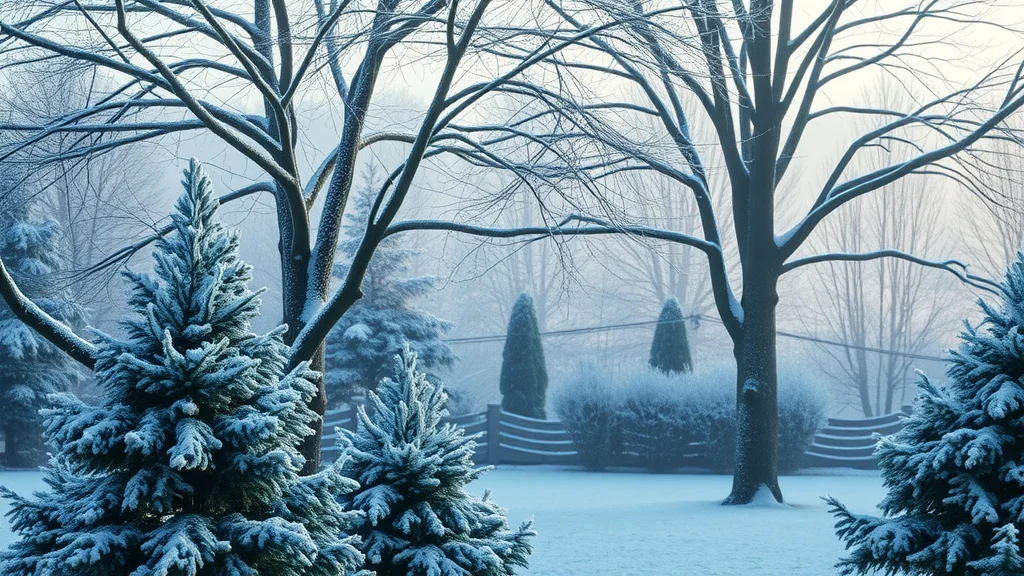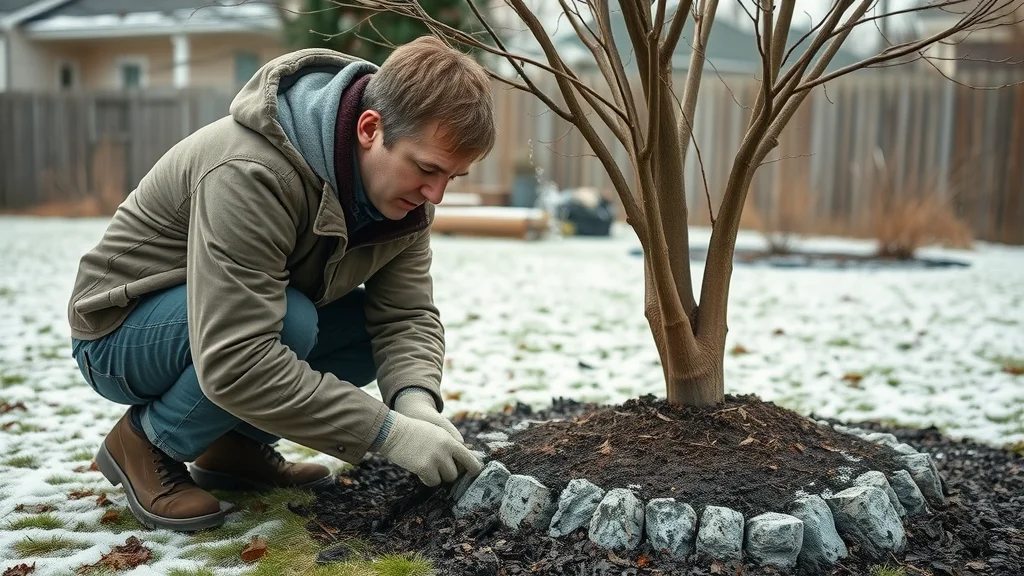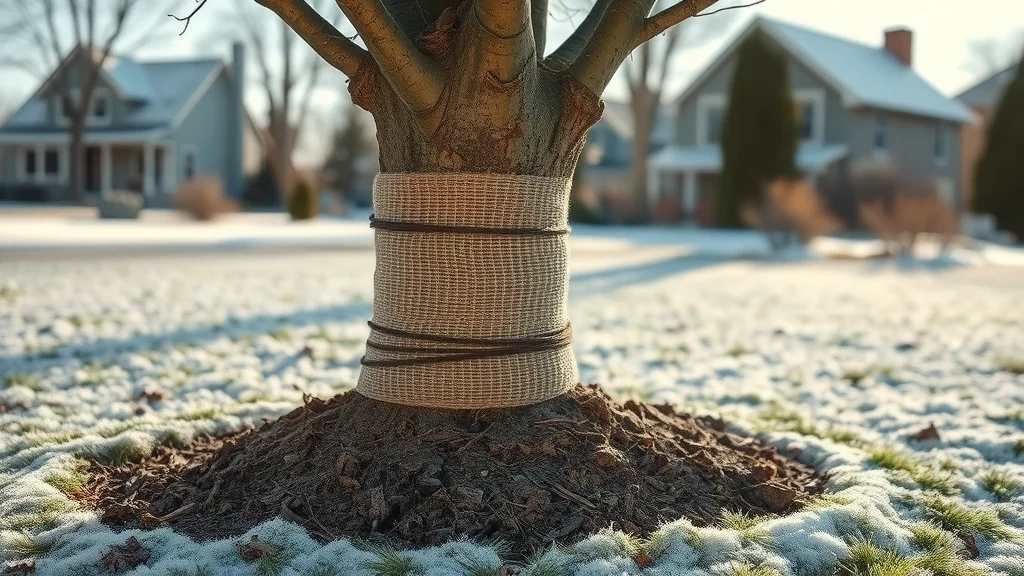Did you know? Many homeowners are surprised to learn that neglecting winter tree watering is a leading cause of tree stress and mortality—even in cold climates. Your trees aren’t hibernating as thoroughly as you think—beneath the frozen ground, their roots still need vital moisture to survive. Ignoring winter tree watering tips can quietly lead to declining health, loss of evergreen color, and even death for your cherished landscape trees.

Startling Facts: Why Winter Tree Watering Tips Matter
The winter months often trick us into thinking trees can simply rely on melting snow or sporadic rain. However, research from the Colorado State Forest Service and other organizations underscores that tree care during a dry winter is critical. Even under snow cover, newly planted trees and established trees can suffer damage during extended dry periods. Trees continue to lose moisture through their needles and bark, making supplemental water in the winter months a game-changer for root systems. Adhering to correct winter tree watering tips helps prevent dieback, strengthens root systems, and ensures strong spring leaf-out.
According to tree care experts and certified arborists, a single oversight in your fall and winter routine—like not watering during a dry period—can result in irreversible damage. Symptoms often go unseen until well into next summer. That’s why winter tree watering is considered essential preventive care for both newly planted and mature trees during winter. Taking action now is much easier and far less costly than trying to nurse a stressed tree back to health.
"Many homeowners are surprised to learn that neglecting winter tree watering is a leading cause of tree stress and mortality—even in cold climates."
What You'll Learn: Your Guide to Winter Tree Watering Tips
- Why winter tree watering tips are vital for tree survival
- How to adapt tree care routines for winter conditions
- Step-by-step methods for watering newly planted trees
- Expert advice for both established and new planted trees
- Common tree watering mistakes to avoid in fall and winter
Understanding Winter Tree Watering Tips: Tree Care Basics
Why Winter Watering Is Crucial for Tree Health
Winter is not a time of true dormancy for most trees. Even as trees and shrubs shed leaves and slow their growth, roots continue absorbing water from the surrounding soil. A prolonged dry period can lead to a depleted root system and unseen stress, especially for newly planted or young trees. Newly planted trees are particularly vulnerable, as their root systems haven’t fully developed the ability to search for deep moisture—making proper watering tips during winter months a lifeline.
Most regions in the northern U.S. (including state forest service guidelines) advise watering trees during winter when there’s little precipitation or when snow cover is sparse. This is not only true for recently planted trees but also for established trees in landscapes. The simple act to apply water to your trees when there’s a dry period can significantly improve their health and survival, preventing the development of brown needles, twig dieback, or stunted spring growth. So, while your lawn rests for the season, remember your trees and their ongoing tree care needs.
While winter watering is essential for tree health, it's also important to consider how severe weather events can impact your landscape and overall safety. For a closer look at how storms can affect trees and what homeowners should be aware of, explore the tragic toll of severe storms in St. Louis and the importance of proactive tree care in protecting your property.
How Cold Temperatures Affect Trees During Winter
When cold snaps hit, the ground can freeze inches deep, trapping roots in a cycle of dehydration. While it’s tempting to think that snow or ice provides all the hydration your trees require, snow cover can be inconsistent—often blown away or evaporated during a sunny dry winter. This means newly planted or sensitive species may go weeks without moisture, increasing the risk of root damage. Tree care professionals emphasize that water delivered directly to the root zone before ground freeze offers roots a protective insurance policy, enabling them to endure cold, dry winter winds.
Additionally, variations in temperature can cause “frost heaving,” where the freeze-thaw cycle lifts soil and exposes roots to biting cold. Applying mulch—one of the best winter tree watering tips—not only retains soil moisture near the root system but also acts as a buffer against rapid temperature changes. This is especially true for small trees, shrubs, and evergreens, which are more susceptible to winter dehydration stress. By monitoring soil moisture, you can ensure your trees receive adequate hydration whenever feasible during the winter months.
When and How Much: Winter Watering Tips for All Trees

How Often Should I Water Trees in Winter?
Consistent, deep watering is the gold standard for trees during winter, but frequency depends on your regional climate and soil type. For many, watering trees once every three to four weeks during periods of little precipitation is ideal. In drier regions (such as those overseen by the Colorado State Forest Service), even established trees need water in winter, particularly during extended dry periods with little or no snow cover.
A key winter tree watering tip is to check soil moisture before watering: if the ground is unfrozen and your finger or a trowel can penetrate down several inches, your tree is still able to utilize supplemental water. Each application should soak the soil to about 12 inches deep, ensuring the entire root system benefits. Overwatering is rarely an issue in winter, but avoid applying water when the ground is frozen solid, as this can cause runoff and root ice damage. Water young or newly planted trees more frequently, as their limited root system and higher evaporation rates make them less drought-tolerant even during cooler times of the year.
Watering Techniques for Established and Newly Planted Trees
The technique you choose makes all the difference. For established trees, the trickle soaking method is preferred: allow water to slowly seep into the soil at the tree’s drip line using a soaker hose or slow-release bag. This targeted approach provides even moisture and avoids creating compaction or puddles that harm the root system. For newly planted trees, pay extra attention to the original planting site and soil structure—use mulch to retain moisture and insulate roots, and always water directly at the base, saturating the root ball.
The best time to apply water is mid-morning on frost-free days, when sunlight helps prevent water from freezing on the surface and maximizes absorption into the root zone. Avoid watering in the evening or if a severe cold front is expected within the next 24 hours. Always check soil moisture by probing the ground—if it’s dry below the mulch layer, it’s time to water. By consistently applying these watering tips, you’ll optimize the soil environment for your trees and shrubs throughout fall and winter.
- Trickle soaking method: Use a soaker hose or watering can to apply water slowly.
- Mulching for moisture retention: Add a 2-4 inch mulch layer around the root zone, avoiding direct trunk contact.
- Root zone targeting: Focus watering at the drip line and root ball.
- Best time of day to water: Water during late morning on frost-free days.

Special Considerations: Newly Planted Trees and Winter Watering
Best Practices for Caring for Newly Planted Trees
Newly planted trees are particularly susceptible to winter dehydration, especially if the soil around them dries out. For these vulnerable trees, deep and infrequent watering is a must—soak the entire planting zone from trunk to drip line with 5-10 gallons every 2-3 weeks, unless the area experiences frequent precipitation. Protect the tree and the soil around it by applying 2-4 inches of mulch, which acts as insulation, keeping roots moderate in temperature and trapping valuable moisture.
Don’t forget: roots of newly planted trees are found closer to the surface than established trees, and they will lose moisture faster during dry periods. Checking soil moisture is key—water whenever the ground is not frozen and the top several inches of soil feel dry. If you are in a region supported by the state forest or forest service resources, follow their local winter watering recommendations. By focusing your winter tree watering tips here, you can nearly double the survival chances for new plantings, ensuring a vibrant spring awakening.
| Tree Type | Watering Frequency | Optimal Water Amount | Additional Care |
|---|---|---|---|
| Newly Planted Trees | Every 2-3 weeks | 5-10 gallons | Mulch, protect roots |
| Established Trees | Every 3-4 weeks | 10-15 gallons | Inspect soil moisture |
"For maximum winter watering benefit, focus on newly planted trees—their survival rates nearly double with consistent care." — Certified Arborist

Winter Watering Tips for Special Situations: Holiday & Ornamental Trees
How to Get Your Christmas Tree to Drink More Water
Keeping your Christmas tree fresh and vibrant through the holiday season is all about consistent watering from day one. As soon as you bring a fresh-cut tree home, make a fresh, straight cut across the base and immediately place it in water. A tree’s vascular tissues begin sealing with sap within hours, reducing its ability to absorb water. Top off the stand every day—trees can quickly drink up to a quart or more in the first few days.
Don’t let the water reservoir go dry. Even a brief lapse can form a seal at the base, drastically reducing water uptake. If your home is dry—especially during a dry winter—consider adding a humidifier to keep tree needles hydrated. Avoid sugary additives or homemade concoctions, as clean, plain water provides the most reliable hydration for your decorative tree’s root system. With the right care, your Christmas tree will remain supple and needle-drop will be at a minimum throughout the holidays.
Is It Better to Water a Christmas Tree with Hot or Cold Water?
Contrary to some popular advice, the temperature of the water is less important than its availability and cleanliness. Although hot water can help with an initial fresh cut by dissolving sap, room temperature or cool tap water is safe for routine watering and is easier to maintain. The Colorado State Forest Service notes that hot water offers no long-term benefits and can sometimes shock the tree. Simply ensure the water stand is never empty, and that the base remains submerged.
Whether you use hot or cold water, focus on a clean container and steady supply. The most critical factor is that water is present at all times, as once a Christmas tree dries out at the base, it won’t recover its ability to drink water properly. This easy-to-follow watering tip will help your tree stay lush, aromatic, and festive through the busy winter months.

Common Winter Tree Watering Mistakes to Avoid During Fall and Winter
- Watering when the ground is frozen: This can cause runoff rather than soaking the root zone, leading to poor absorption.
- Overwatering soil with poor drainage: Trees and shrubs suffer when their roots sit in cold, soggy soil—always check soil moisture before watering.
- Ignoring newly planted trees after the first frost: These trees continue to need water, even after leaves drop and winter hits.
- Underestimating the needs of evergreen varieties: Evergreens lose water through their needles throughout winter and need consistent monitoring and supplemental water during extended dry periods.
Watch: How to check for soil moisture and properly water trees in winter conditions. This expert-led instructional video includes real-life outdoors demonstrations, closeups of soil and tree roots, and practical winter watering tips from a certified arborist.
Expert Tree Care: How to Keep Trees from Dying in the Winter
Key Takeaways: Winter Tree Watering Tips Summary
- Deep, infrequent watering is more effective than daily shallow watering for both newly planted and established trees.
- Monitor soil moisture regularly, especially near newly planted trees and evergreens during dry periods.
- Frost-free, sunny days are the best for watering trees to avoid freezing issues and maximize absorption in the root zone.
- Consistent winter tree watering tips and careful tree care can double survival rates for sensitive species and maintain vibrant landscape health year-round.
People Also Ask: Answers to Common Winter Tree Watering Questions
How do you keep trees from dying in the winter?
To keep trees healthy during the harsh winter months, focus on a combination of strategic watering and protective mulching. Make sure to water on frost-free days, providing deep moisture to the root system about once every three to four weeks, especially during extended dry periods. Apply a mulch layer 2-4 inches thick around each tree’s base (but keep it from touching the trunk) to help insulate against extreme temperature swings and moisture loss. For newly planted or sensitive trees, consider extra protection such as burlap wraps and windbreaks. Regularly check soil moisture to ensure trees and shrubs receive supplemental water when needed. These winter tree watering tips are widely recommended by certified arborists and the Colorado State Forest Service for reducing tree mortality, even during a dry winter.

FAQs: Winter Tree Watering Tips and Tree Care Insights
-
Can winter tree watering tips prevent frost damage?
Yes. Providing consistent moisture prevents roots from drying out and becoming vulnerable to freeze-thaw cycles. Adequate water also helps roots retain heat, buffering the tree against sudden winter temperature drops. -
How can I tell if my tree needs more water during winter?
Test soil moisture by pushing a trowel or screwdriver several inches below the mulch layer. If the soil feels dry below the surface, it’s time to water. Checking regularly, especially for newly planted trees, ensures you’ll provide water only when necessary. -
What is the best mulch for winter tree care?
Natural organic mulches such as shredded bark, wood chips, or composted leaves are best. They help retain moisture, regulate soil temperatures, and break down over time, nourishing the root systems. -
Is drip irrigation effective in cold months?
Yes, a soaker hose or drip irrigation system can deliver water slowly and efficiently, especially during a dry winter. Always drain and store hoses before a hard freeze. -
Are there special winter watering tips for fruit trees?
Fruit trees, especially young or newly planted ones, benefit greatly from regular monitoring and supplemental watering during extended dry spells in fall and winter. Mulch around the root zone and avoid overwatering.
Conclusion: Implementing Winter Tree Watering Tips in Your Landscaping Routine
Start applying these essential winter tree watering tips today to protect your landscape, ensuring that your trees and shrubs thrive through the harshest months and burst into life next spring.
If you’re ready to take your tree care knowledge to the next level, consider how broader environmental factors and severe weather can influence your landscape’s health and safety. Learning from real-world events, such as the devastating impact of storms in St. Louis, can help you develop a more resilient and proactive approach to tree maintenance. Discover how understanding storm risks and implementing preventive strategies can safeguard both your trees and your home by reading about the lessons from severe storms and the importance of homeowner safety. By expanding your expertise, you’ll be better equipped to nurture a thriving, secure landscape year-round.
Grow Your Knowledge: Learn More About Tree Care and Winter Tree Watering
Ready to keep your trees resilient through every season? Grow your landscaping expertise—call 203-271-7991 or visit TreeGuardianNews.com to subscribe.
Ensuring your trees receive adequate water during the winter months is crucial for their health and vitality. For comprehensive guidance, consider the following resources:
-
The Arbor Day Foundation provides detailed insights in their article, “Winter Tree Watering Tips,” covering essential practices such as optimal watering times, techniques, and the importance of mulching to retain soil moisture.
-
The Colorado State Forest Service offers region-specific advice in their publication, “Winter Tree Watering Necessary During Drought Conditions,” emphasizing the significance of watering during warm days and providing practical tips for effective winter tree care.
By consulting these resources, you’ll gain valuable knowledge to implement effective winter watering strategies, ensuring your trees remain healthy and resilient throughout the colder months.
 Add Row
Add Row  Add
Add 




Write A Comment